Noche de Rabanos 2024: Night of the Radishes Festival Oaxaca
Noche de Rabanos, or Night of the Radishes, is one of the most anticipated events of the holiday season in Oaxaca.
The Oaxaca radish festival began over 100 years old when there was a prolific radish crop. Today people travel from throughout Mexico and the state of Oaxaca to see the giant radishes carved with depictions of Oaxacan life.
Let’s take a deeper look at La Noche de los Rabanos as I explain its history and how you can experience this event yourself.
I’ve included some fun facts about the Night of the Radishes as well as some tips for the festival.
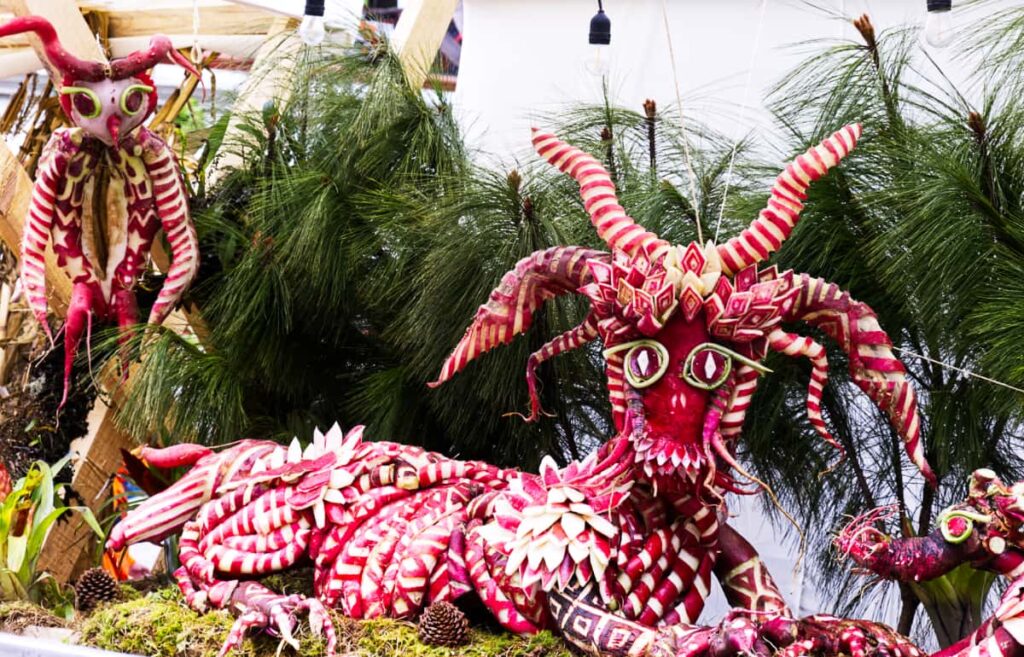
Why Do They Celebrate Night of the Radishes?
The Night of the Radishes has become a celebration of Oaxaca itself. And I believe that is one reason Noche de Rabanos is so popular and continues to be celebrated.
For some Oaxacan families, La Noche de los Rabanos is as important as celebrating Christmas. The depictions carved into the giant radishes honor everything that is Oaxaca – its people, its culture, and its food.
The participants of the Night of the Radishes are residents of Oaxaca and the surrounding villages, ranging in age from young to old. Many of the participants continue the legacy of their families that have been competing in the Oaxaca radish festival for decades.
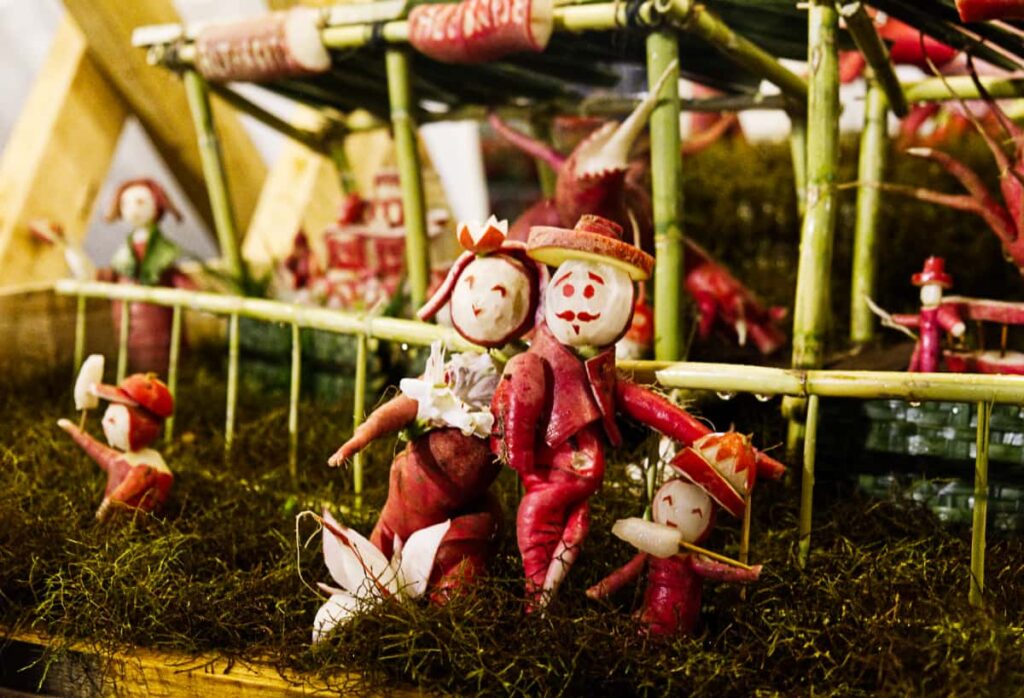
How Is the Night of the Radishes Celebrated?
Noche de Rabanos is held in the Zocalo, or main square, of Oaxaca City. The Zocalo is located in the center of the city.
Unlike most festivals in Oaxaca whose celebrations stretch into days and weeks, the Night of the Radishes lasts only one day and night.
Update 2024 – The city of Oaxaca added a parade to celebrate the radish festival and its participants. Because what is a celebration in Oaxaca without a parade?
On the morning of December 23rd, the artists arrive in the Zocalo to finish carving and assemble their radish creations. By midday, most of the work has been completed. Although the artists stay at their booth to greet onlookers and spritz the radishes with water to keep them looking fresh.
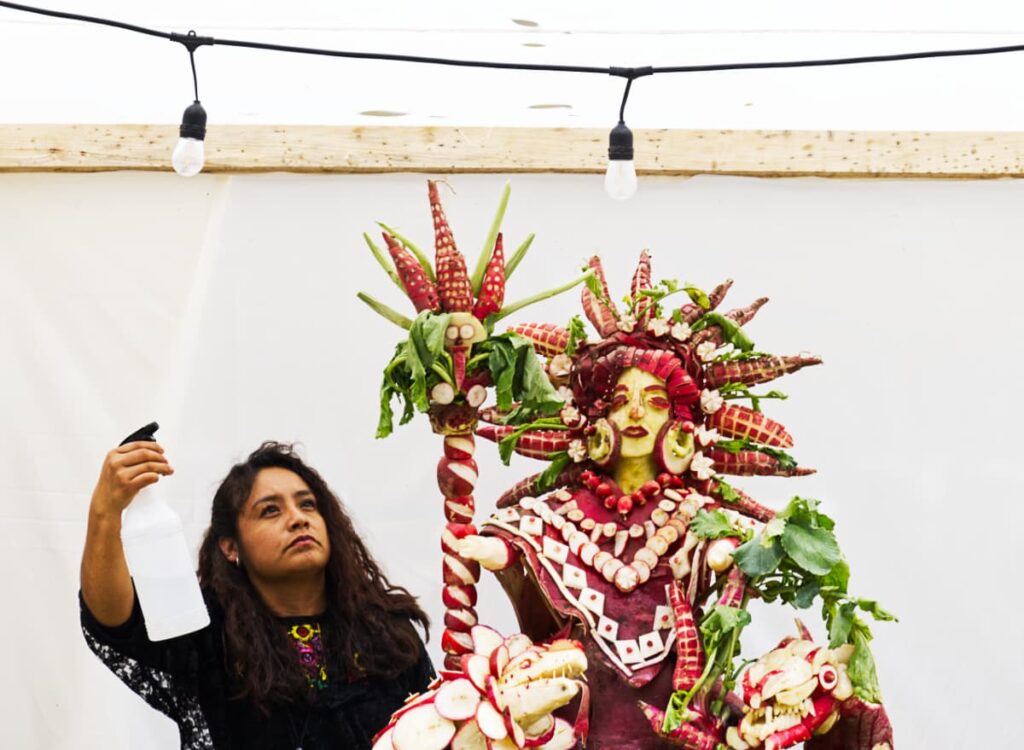
While you can see the displays throughout the day, the Oaxaca radish festival technically begins at 3 pm. At night, the carved radishes are lit up, creating an idyllic scene during Christmas in Oaxaca.
If you prefer to avoid the long wait times you should go to Noche de Rabanos during the day or just as it opens. If you want to see them at night, you should arrive around 4:30 pm and expect to wait in line for 2-3 hours. Around 9 pm on December 23rd, the winners of the Oaxaca radish festival competition are announced.
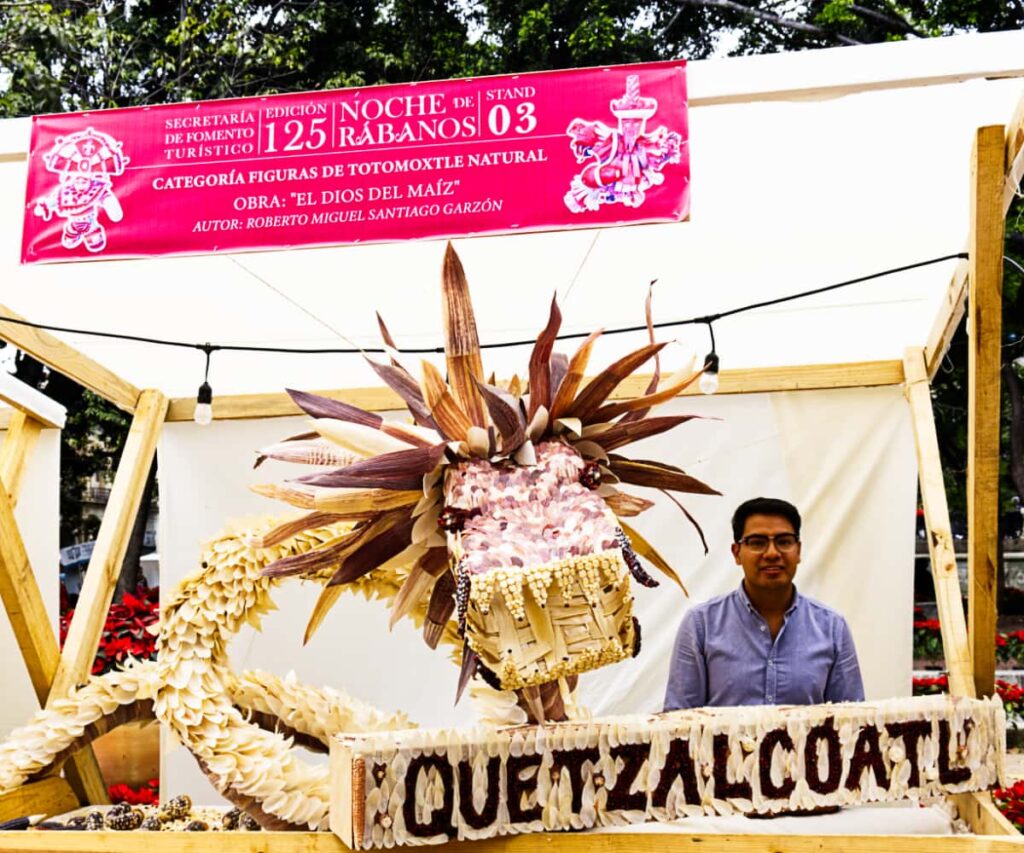
Where Did Night of the Radishes Originate?
The origins of the Night of the Radishes date back to the end of the 19th century. At that time, a Christmas Market was held in Oaxaca’s Zocalo each year on Christmas Eve.
This market sold dried fish and shrimp, herbs, and of course vegetables and other items Oaxaqueños needed to prepare Christmas dinner.
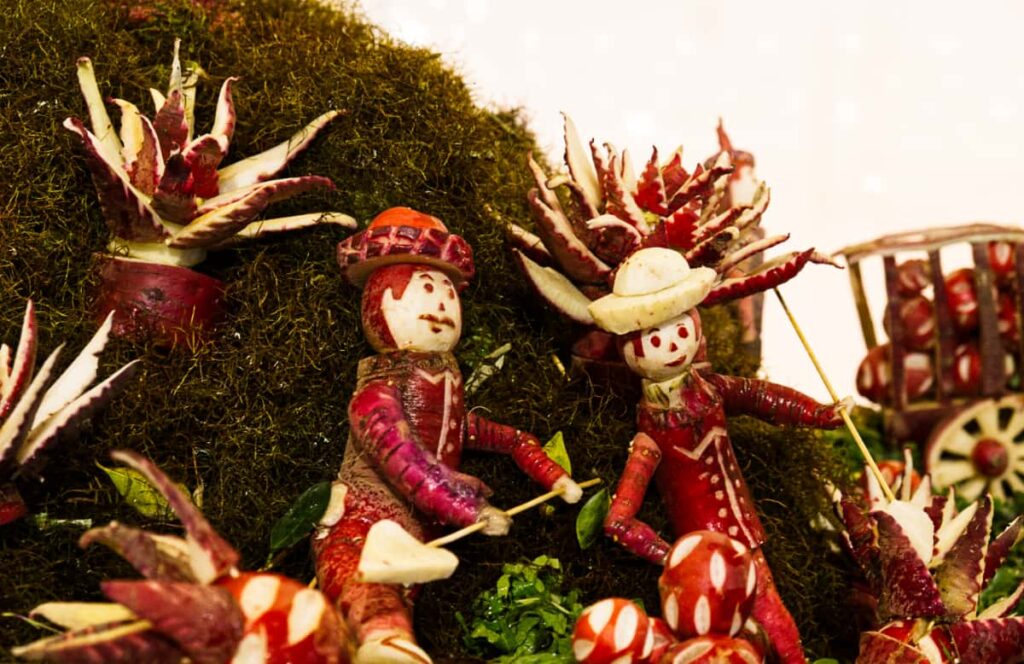
As one legend goes, the Oaxaca radish crop was so abundant one year that some radishes were forgotten and not harvested on time. When the radishes were dug up months later, they were very large and resembled different figures.
The giant radishes were brought to the Christmas Eve Market in Oaxaca, where they were then carved to draw the attention of the clients to the vegetable stands. The carved radishes were a hit and in 1897, the mayor proposed an annual radish festival in Oaxaca with a prize for the top contestants.
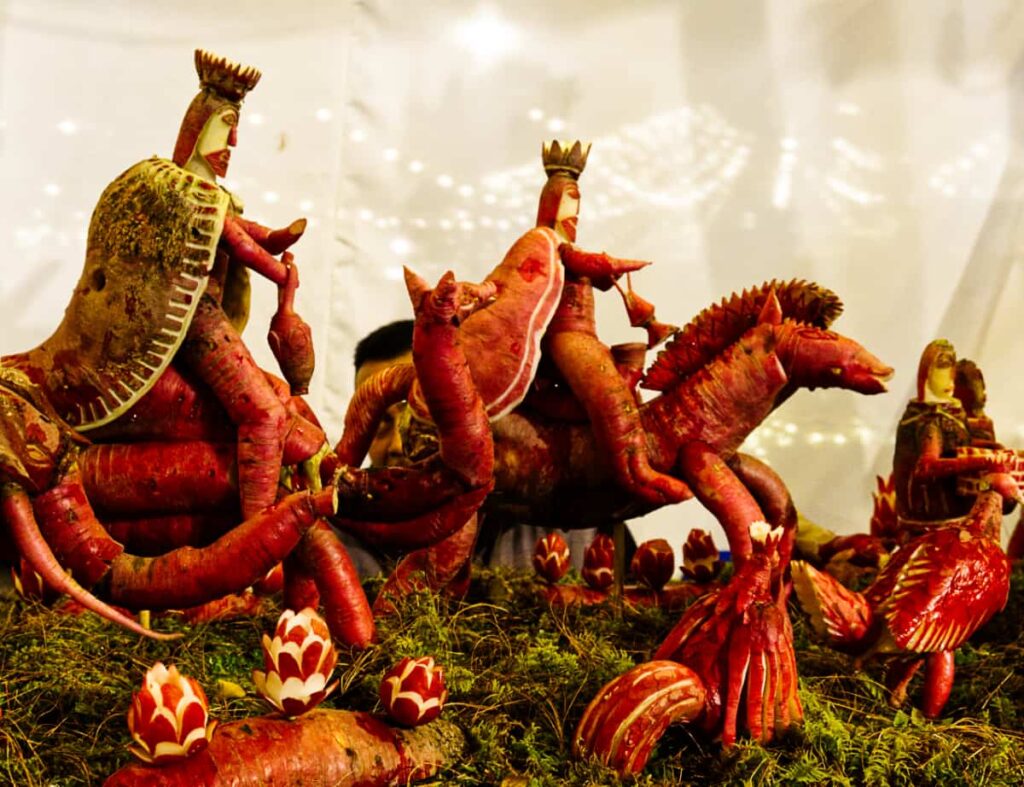
What Do the Artisans Create with the Radishes?
For the Night of the Radishes, the artisans create a variety of scenes out of the giant radishes. For example, the carved radishes become sculptures of mythical creatures, the Virgin of Guadalupe, and other biblical scenes.
There are also depictions of Oaxacan life, including the mole and cacao making process, local handicrafts, and the famous festivals of Dia de los Muertos and Guelaguetza. In fact, you could say the radish creations are only limited by the artists’ imagination.
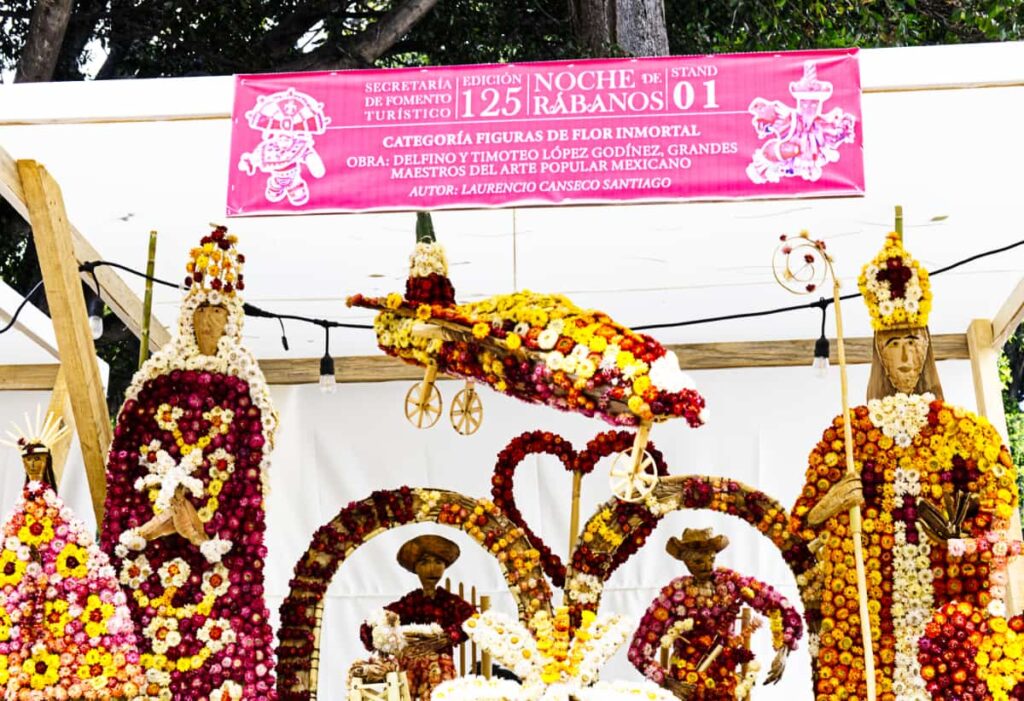
In addition to the two main radish carving categories (traditional and open theme), there are two other main categories of the Noche de Rabanos competition. In the Totomoxtle category, artisans use corn husks to make their creations. And in the Flor Immortal they use small dried flowers to create intricate scenes.
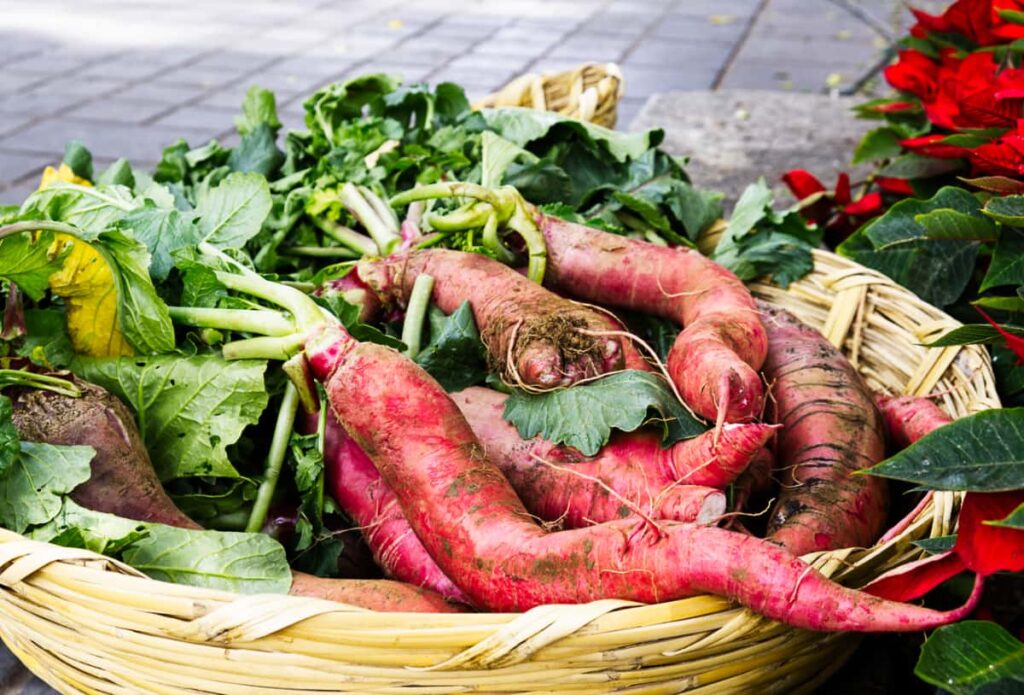
Fun Facts About the Night of the Radishes
- In order to keep the competition fair, the government of Oaxaca plants the radishes used for Noche de Rabanos in a designated field near the airport.
- They are planted in various intervals over the course of three months leading up to the Oaxaca radish festival to give the artisans variety in the size of the radishes.
- A few days before the competition, entrants go to the field to dig up their giant radishes. Each entrant is assigned a plot number based on the order in which they signed up for the competition.
- Each year around 10 tons of radishes are harvested for the Night of the Radishes competition.
- Some of the radishes used in Noche de Rabanos can weigh up to 7 pounds.
- These giant radishes are not edible since chemicals are used during the growing process to make them larger.
- The top winner in each category wins as much as 30,000 pesos (about $1500 USD).
Noche de Rabanos is a unique annual event in Oaxaca, Mexico. It’s amazing to see scenes of Oaxaca depicted in these carved radishes that last only one day.
If you’re celebrating the holiday season in Oaxaca, I highly recommend checking out this beloved holiday tradition.
FAQ About The Night of the Radishes
Who celebrates The Night of the Radishes?
The Night of the Radishes is celebrated by residents of Oaxaca City and the surrounding villages as well as visitors who come from throughout Mexico and other parts of the world to view the carved radish creations.
Why do people celebrate The Night of Radishes?
People celebrate the Night of Radishes for many reasons. It is an opportunity to engage in a tradition that has been around for over a century, as well as promote cultural pride in the region and its foods. Additionally, it marks a festive time of year that brings families together to celebrate the holiday season.
What happens on The Night of the Radishes?
On the Night of the Radishes, artisans from Oaxaca and surrounding villages come together to create intricate scenes out of giant radishes. They use a variety of carving techniques to make sculptures of mythical creatures, biblical scenes, depictions of Oaxacan life, and more. The creations are then lit up at night and placed in a competition for judging. Artists also stay at their booths to greet onlookers and spritz the radishes with water to keep them looking fresh. At 9 pm on December 23rd, the winners are announced and rewarded for their creativity.
When did The Night of the Radishes begin?
The Night of the Radishes began in the late 19th century. As one legend goes, one year the Oaxaca radish crop was so abundant that some radishes were forgotten. When the radishes were dug up months later, they were very large and resembled different figures. The giant radishes were brought to the Christmas Eve Market in Oaxaca, where they were then carved to draw attention to the vegetable stands. In 1897, the mayor proposed an annual radish festival in Oaxaca with a prize for the top contestants.
How long does The Night of the Radishes last?
The Night of the Radishes lasts for one night, on December 23rd. The festivities begin in the afternoon and culminate with a ceremony to announce the winners at 9 pm.
Who participates in The Night of the Radishes?
Artisans from Oaxaca and surrounding villages participate in The Night of the Radishes. Many participants carry on the tradition of their families that have been partaking in the festivities for decades. It is a beloved event for many and brings families together during the holiday season to share music, dance, food, and other activities.
In what Mexican city is Night of the Radishes celebrated?
Night of the Radishes is celebrated in Oaxaca City, Mexico. It is an annual event that takes place on December 23rd and attracts visitors from other parts of Mexico and the world to view the carved radish creations.

